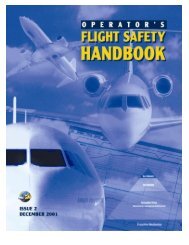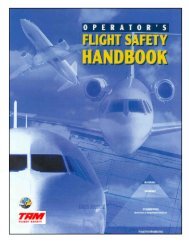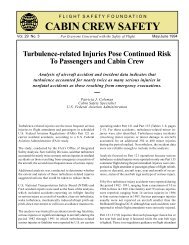Download PDF [10.9 MB] - Flight Safety Foundation
Download PDF [10.9 MB] - Flight Safety Foundation
Download PDF [10.9 MB] - Flight Safety Foundation
You also want an ePaper? Increase the reach of your titles
YUMPU automatically turns print PDFs into web optimized ePapers that Google loves.
FLIGHTSAFETY.ORG | AEROSAFETYWORLD | MAY 2013<br />
HELICOPTERS<br />
Control Lost During Search<br />
MD Helicopters MD902. Destroyed. Three serious injuries.<br />
The pilot, flight engineer and forwardlooking<br />
infrared radar (FLIR) operator<br />
aboard the state police helicopter were<br />
searching for a missing person near Engelsbrand,<br />
Germany, in night VMC on May<br />
10, 2011. The helicopter was circling about<br />
600 ft above a hill when the radar operator<br />
announced that the FLIR was showing an<br />
unidentified heat source.<br />
The pilot and flight engineer donned night<br />
vision goggles (NVGs). The pilot then maneuvered<br />
the MD902 close to the displayed heat<br />
source and reduced speed to place the helicopter<br />
in a hover. “Suddenly, the helicopter yawed to<br />
the right,” said the report by the German Federal<br />
Bureau of Aircraft Accident Investigation. “He<br />
responded [by] actuating the left pedal up to the<br />
mechanical stop.”<br />
However, the helicopter continued to<br />
yaw right and then descended out of control<br />
into the forest. All three occupants sustained<br />
serious injuries. The radar operator exited<br />
the wreckage unaided; the pilot and flight<br />
engineer were rescued by police ground<br />
crewmembers.<br />
The report concluded that visual restrictions<br />
resulting from the use of the NVGs,<br />
distractions caused by the search for the missing<br />
person, and a “loss of spatial perception”<br />
were among factors that likely contributed to<br />
the accident.<br />
“It is likely that while trying to position the<br />
helicopter as close as possible to the identified<br />
heat source, an unnoticed loss of altitude and<br />
backward movement of the helicopter occurred,”<br />
the report said. “It is highly likely that<br />
the restricted spatial perception of the pilot due<br />
to the NVGs contributed to the occurrence; the<br />
same is true for crewmembers whose attention<br />
was focused on the search.”<br />
ONRECORD<br />
Distracted by Radio Call<br />
Eurocopter AS350 B2. Substantial damage. Three minor injuries.<br />
The pilot, who had recently purchased the helicopter,<br />
was receiving training by a certified<br />
flight instructor (CFI) at Alliance Airport in<br />
Fort Worth, Texas, U.S., the morning of May 29,<br />
2011. “During practice traffic pattern work, the<br />
helicopter’s hydraulic system was turned off to<br />
simulate hydraulic failure on the flight control<br />
system,” the NTSB report said.<br />
During the subsequent approach, the CFI<br />
and the pilot may have been distracted when<br />
an airport traffic controller advised that they<br />
were using an incorrect radio frequency, the<br />
report said. While the instructor was setting<br />
the correct frequency, the helicopter slowed and<br />
entered an uncommanded left yaw.<br />
“The CFI tried to regain control by adding<br />
right pedal, trying to gain forward airspeed, and<br />
reducing power,” the report said. “The helicopter<br />
did not respond to the CFI’s control inputs,<br />
descended and impacted terrain.” The pilot, CFI<br />
and passenger sustained minor injuries.<br />
Loose Nut Causes Power Loss<br />
Bell 206B. Substantial damage. No injuries.<br />
After the JetRanger’s engine lost power during<br />
an aerial-application flight near Burbank,<br />
Washington, U.S., on May 30, 2012, the pilot<br />
conducted an autorotative landing in an apple<br />
orchard. “During the landing, the rotor blades<br />
impacted the trees and the tail boom separated<br />
from the main fuselage,” the NTSB report said.<br />
Maintenance records showed that the helicopter<br />
had been flown six hours since the engine<br />
bleed air valve was replaced. Investigators<br />
determined that maintenance personnel had not<br />
applied sufficient torque to secure a B-nut that<br />
attaches the compressor discharge pressure air<br />
tube to the engine. The B-nut had backed off the<br />
stud during the accident flight, causing the air<br />
tube to detach and the engine to lose power.<br />
| 59


![Download PDF [10.9 MB] - Flight Safety Foundation](https://img.yumpu.com/18550968/61/500x640/download-pdf-109-mb-flight-safety-foundation.jpg)

![Download this Issue [PDF 7 MB] - Flight Safety Foundation](https://img.yumpu.com/18859635/1/190x245/download-this-issue-pdf-7-mb-flight-safety-foundation.jpg?quality=85)
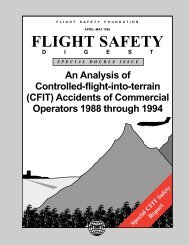
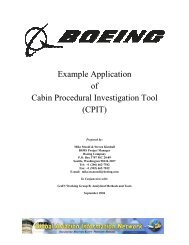
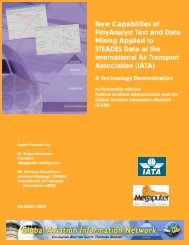
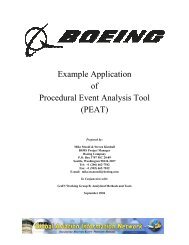

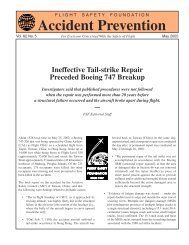
![Download [PDF 8 MB] - Flight Safety Foundation](https://img.yumpu.com/18859366/1/190x245/download-pdf-8-mb-flight-safety-foundation.jpg?quality=85)
